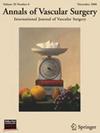老年患者胸主动脉置换术后1年腰肌面积减少的影响因素。
IF 1.6
4区 医学
Q3 PERIPHERAL VASCULAR DISEASE
引用次数: 0
摘要
目的:探讨≥65岁择期胸主动脉置换术患者术前至术后1年腰肌面积(PMA)的变化率,并确定影响PMA下降的因素。方法:在这项单中心回顾性研究中,测量了73例患者的PMA(中位年龄75岁;25名女性)术前和术后1年。通过单因素和多因素分析确定胸主动脉置换术后影响PMA下降的因素。根据胸主动脉置换术后1年PMA与术前相比是否下降,将患者分为两组。结果:减少组38例,非减少组35例。单因素logistic回归分析结果选择男性(P = 0.004)、术前体重指数(BMI) (P = 0.020)和术后6分钟步行距离(6mwd)未能恢复到术前值(P = 0.012)进行多因素分析。多因素logistic回归分析发现,男性(优势比(OR) = 5.019, 95%可信区间(CI) = 1.527 ~ 16.499, P = 0.008)、术前BMI (OR = 1.190, 95% CI = 1.004 ~ 1.410, P = 0.045)、术后6 MWD未能恢复到术前值(OR = 9.617, 95% CI = 1.590 ~ 58.152, P = 0.014)是PMA下降的独立预测因素。结论:男性、术前BMI、术后6 MWD未能恢复到术前值是影响胸主动脉置换术后1年PMA下降的独立因素。本文章由计算机程序翻译,如有差异,请以英文原文为准。
Factors Affecting the Decrease in Psoas Muscle Area 1 Year After Thoracic Aortic Replacement in Older Patients
Background
To investigate the rate of change in the psoas muscle area (PMA) from the preoperative period to 1 year postoperatively in patients aged ≥65 years undergoing elective thoracic aortic replacement and identify factors influencing PMA decrease at 1 year.
Methods
In this single-center retrospective study, PMA was measured in 73 patients (median age, 75 years; 25 women) preoperatively and 1 year postoperatively. Factors affecting PMA decreased after thoracic aortic replacement were identified using univariate and multivariate analyses. Patients were divided into 2 groups based on whether their PMA had decreased 1 year after thoracic aortic replacement compared to the preoperative value.
Results
The decrease and nondecrease groups comprised 38 and 35 patients, respectively. From the univariate logistic regression analysis results, male sex (P = 0.004), preoperative body mass index (BMI) (P = 0.020), and failure of postoperative 6-min walk distance (6 MWD) to recover to the preoperative value (P = 0.012) were selected for the multivariate analysis. Multivariate logistic regression analysis identified male sex (odds ratio (OR) = 5.019, 95% confidence interval (CI) = 1.527–16.499, P = 0.008), preoperative BMI (OR = 1.190, 95% CI = 1.004–1.410, P = 0.045), and failure of postoperative 6 MWD to recover to the preoperative value (OR = 9.617, 95% CI = 1.590–58.152, P = 0.014) as independent predictors of PMA decrease.
Conclusion
Male sex, preoperative BMI, and failure of postoperative 6 MWD to recover to the preoperative value were independent factors influencing the decrease in PMA 1 year after thoracic aortic replacement.
求助全文
通过发布文献求助,成功后即可免费获取论文全文。
去求助
来源期刊
CiteScore
3.00
自引率
13.30%
发文量
603
审稿时长
50 days
期刊介绍:
Annals of Vascular Surgery, published eight times a year, invites original manuscripts reporting clinical and experimental work in vascular surgery for peer review. Articles may be submitted for the following sections of the journal:
Clinical Research (reports of clinical series, new drug or medical device trials)
Basic Science Research (new investigations, experimental work)
Case Reports (reports on a limited series of patients)
General Reviews (scholarly review of the existing literature on a relevant topic)
Developments in Endovascular and Endoscopic Surgery
Selected Techniques (technical maneuvers)
Historical Notes (interesting vignettes from the early days of vascular surgery)
Editorials/Correspondence

 求助内容:
求助内容: 应助结果提醒方式:
应助结果提醒方式:


